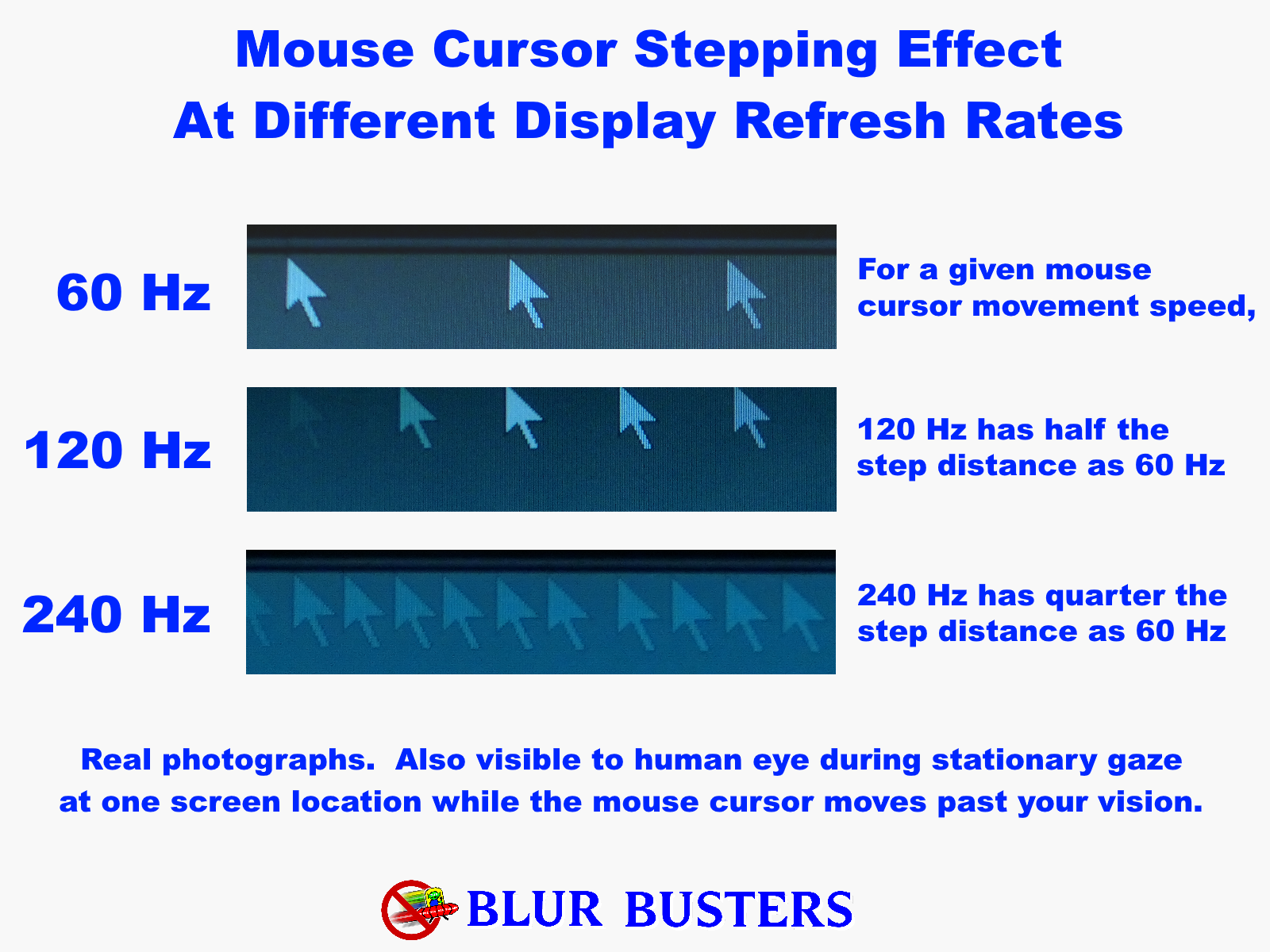Page 2 of 2
Re: Fastest IPS monitor
Posted: 28 Oct 2025, 03:05
by Discorz
yuri wrote: ↑26 Oct 2025, 15:14
But also oled can make the stroboscopic effect much more visible because there is less gtg blur than regular lcd gtg.
Stroboscopic effect (from frame rate) is not something you want to "remove" like the GtG ghosting during tracking. Instant GtG remains a requirement so frames can pop in and out as quickly as possible. Otherwise you'd see objects on screen fade in-out/teleport from position to position. For example, I can still see GtG delaying the response during fixed gaze (same as smearing during tracking) on my very slow VA. So for less stroboscopic effect you want more of the frames packed tightly to blend into continuous blur along with fast GtG. Besides, frame rate is a problem. Sadly, the bar is currently set too low.

Stationary Eye vs Moving Mouse Cursor at 3840 px/sec speed, GtG = 0 ms
We have people being fine with 60 fps, and I'm here complaining 1000 fps is not enough.
Re: Fastest IPS monitor
Posted: 30 Oct 2025, 17:58
by Chief Blur Buster
yuri wrote: ↑26 Oct 2025, 15:14
But also oled can make the stroboscopic effect much more visible because there is less gtg blur than regular lcd gtg.
Yes, but not in all the ways some people think.
1. During strobing disabled (no BFI, no strobe), and doing a fixed gaze situation -- the count of duplicate images do not increase. However, fast GtG makes any duplicate images appear/disappear more abrupt (they don't fade-in-and-out over the GtG milliseconds). So this can amplify the stroboscopic effect feel. You can see
LCD vs OLED pixel response via high speed camera as well as
The Stroboscopic Effect of Finite Frame Rates.
2. The stutter-to-blur continuum (
Animation Demo) on LCDs will be slightly below 60fps on LCD but slightly above 60fps on OLED. What this means is that 60fps stutters worse on OLEDs than LCDs. At GtG=0, the stutter-to-blur threshold can equalize with your specific flicker fusion threshold. This can amplify visibility of double images.

As a rule of thumb, most people don't notice a difference in the duplicate images on LCD vs OLED when strobing is disabled. Ironically, the slow GtG can add additional duplicate images by a fade trail before/after. But, it is 'gentler' and less 'sudden' so human perception of duplicate images will vary a bit between LCD vs OLED.
Re: Fastest IPS monitor
Posted: 15 Nov 2025, 19:34
by yuri
Chief Blur Buster wrote: ↑30 Oct 2025, 17:58
yuri wrote: ↑26 Oct 2025, 15:14
But also oled can make the stroboscopic effect much more visible because there is less gtg blur than regular lcd gtg.
Yes, but not in all the ways some people think.
1. During strobing disabled (no BFI, no strobe), and doing a fixed gaze situation -- the count of duplicate images do not increase. However, fast GtG makes any duplicate images appear/disappear more abrupt (they don't fade-in-and-out over the GtG milliseconds). So this can amplify the stroboscopic effect feel. You can see
LCD vs OLED pixel response via high speed camera as well as
The Stroboscopic Effect of Finite Frame Rates.
2. The stutter-to-blur continuum (
Animation Demo) on LCDs will be slightly below 60fps on LCD but slightly above 60fps on OLED. What this means is that 60fps stutters worse on OLEDs than LCDs. At GtG=0, the stutter-to-blur threshold can equalize with your specific flicker fusion threshold. This can amplify visibility of double images.

As a rule of thumb, most people don't notice a difference in the duplicate images on LCD vs OLED when strobing is disabled. Ironically, the slow GtG can add additional duplicate images by a fade trail before/after. But, it is 'gentler' and less 'sudden' so human perception of duplicate images will vary a bit between LCD vs OLED.
And what about strobing mode like Dyac do you get the exact same type of stroboscopic effect on oled?
I'm always wondering because duplicated images trigger me but with BFI? does the motion is free of the image gap or not ?
Can i have a sample test on video at high speed ?
Re: Fastest IPS monitor
Posted: 17 Nov 2025, 19:14
by Chief Blur Buster
yuri wrote: ↑15 Nov 2025, 19:34
And what about strobing mode like Dyac do you get the exact same type of stroboscopic effect on oled?
For stationary gaze, the stroboscopic effect is the same.
See
www.testufo.com/mousearrow on any display (CRT, LCD, OLED).
yuri wrote: ↑15 Nov 2025, 19:34
I'm always wondering because duplicated images trigger me but with BFI? does the motion is free of the image gap or not ?
You need:
1. Enable GPU motion blur;
2. If you hate motion blur, combine GPU motion blur + high framerate (300fps+). GPU motionblur is usually 0.5-1.0 times frametime in simulated camera shutter, so higher framerate.
Mind you, there's much less noticeable stroboscopics at 480fps 480Hz, if you want to get an ultra-high Hz display. Spray as much framerate as possible (500-1000fps) to close the gaps for motionspeeds of 500-1000 pixels/sec.
yuri wrote: ↑15 Nov 2025, 19:34
Can i have a sample test on video at high speed ?
It won't tell you as much you'd think. Stationary camera and moving camera looks different. Stationary eye and moving eye looks different. See
https://testufo.com/eyetracking

